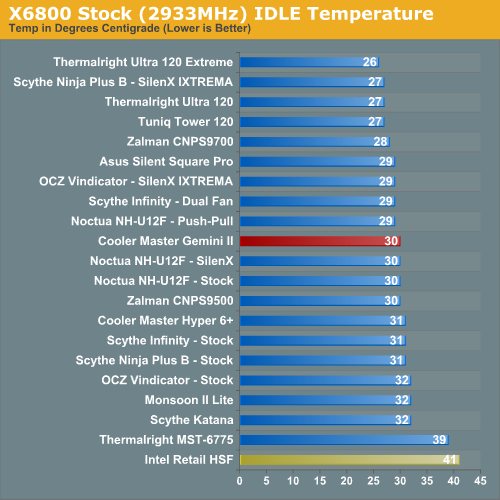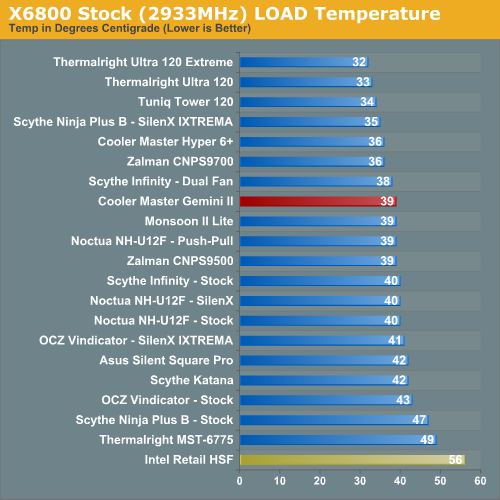Cooler Master GeminII: Performer or Poser?
by Wesley Fink on April 30, 2007 2:00 AM EST- Posted in
- Cases/Cooling/PSUs
Cooling at Stock Speed
Some users will never overclock their CPU, but they still want to run the coolest CPU temperatures possible to enhance stability and extend CPU life. The Cooler Master GeminII does not come with fans, so we tested with four fan configurations as detailed on page four. Since there was little difference in performance among the four fan configurations results are reported with the dual Noctua SF12 configuration. This was the only tested configuration that managed to hold noise below the system noise floor while still cooling at temperatures very close to the high-output 110+63CFM fan configuration.

Where the very good Intel stock cooler keeps the X6800 at 41C at idle, the CoolerMaster GeminII manages 30C in most fan configurations. This is a significant improvement over the Intel stock cooler performance, but it is still far from the best we have tested. The Thermalright coolers, at the top of our heatpipe tower performance charts, cool to 26C and 27C, and the Tuniq 120 maintains 27C. The GeminII is obviously not the best stock idle cooler we have tested, but it is broadly competitive.
It is more difficult to effectively simulate a computer being stressed by all of the conditions it might be exposed to in different operating environments. For most home users CPU power is most taxed with contemporary gaming. Therefore our stress test simulates running a demanding contemporary game. The Far Cry River demo is looped for 30 minutes and the CPU temperature is captured at four second intervals with the NVIDIA monitor "logging" option. The highest temperature during the load test is then reported. Momentary spikes are ignored, as we report a sustained high-level temp that you would expect to find in this recording configuration.
Cooling efficiency of the GeminII was compared under load conditions at stock speed to the retail HSF and other recently tested CPU coolers.

The GeminII under load at stock speeds reached a maximum temperature of 39C with most fan configurations. Best performance was with a Silverstone 110CFM fan plus Scythe SFLEX configuration at 38C. This was only 1C cooler with a big increase in noise. This performance compares to the Thermalright coolers at 32C and 33C, the Tuniq at 34C and the Cooler Master Hyper 6+ and Zalman 9700 at 36C. Stock load performance is average at best among tested coolers.
Some users will never overclock their CPU, but they still want to run the coolest CPU temperatures possible to enhance stability and extend CPU life. The Cooler Master GeminII does not come with fans, so we tested with four fan configurations as detailed on page four. Since there was little difference in performance among the four fan configurations results are reported with the dual Noctua SF12 configuration. This was the only tested configuration that managed to hold noise below the system noise floor while still cooling at temperatures very close to the high-output 110+63CFM fan configuration.

Where the very good Intel stock cooler keeps the X6800 at 41C at idle, the CoolerMaster GeminII manages 30C in most fan configurations. This is a significant improvement over the Intel stock cooler performance, but it is still far from the best we have tested. The Thermalright coolers, at the top of our heatpipe tower performance charts, cool to 26C and 27C, and the Tuniq 120 maintains 27C. The GeminII is obviously not the best stock idle cooler we have tested, but it is broadly competitive.
It is more difficult to effectively simulate a computer being stressed by all of the conditions it might be exposed to in different operating environments. For most home users CPU power is most taxed with contemporary gaming. Therefore our stress test simulates running a demanding contemporary game. The Far Cry River demo is looped for 30 minutes and the CPU temperature is captured at four second intervals with the NVIDIA monitor "logging" option. The highest temperature during the load test is then reported. Momentary spikes are ignored, as we report a sustained high-level temp that you would expect to find in this recording configuration.
Cooling efficiency of the GeminII was compared under load conditions at stock speed to the retail HSF and other recently tested CPU coolers.

The GeminII under load at stock speeds reached a maximum temperature of 39C with most fan configurations. Best performance was with a Silverstone 110CFM fan plus Scythe SFLEX configuration at 38C. This was only 1C cooler with a big increase in noise. This performance compares to the Thermalright coolers at 32C and 33C, the Tuniq at 34C and the Cooler Master Hyper 6+ and Zalman 9700 at 36C. Stock load performance is average at best among tested coolers.










44 Comments
View All Comments
acejj26 - Monday, April 30, 2007 - link
Page 4...MHz, not GHzAnnihilatorX - Monday, April 30, 2007 - link
I have a feeling that the size of CPU coolers is directionaly proportional to the trend of global warmingDon't take this too seriously
Though the CPU TDPs are relatively constant at ~110W for high end CPUs, the coolers have been more and more elaborate.
Wesley Fink - Monday, April 30, 2007 - link
While TDP (Thermal Design Power or Thermal Design Point)has not varied a great deal recently, the wattage demands of a CPU in overclocking are MUCH higher than at stock speed, and they increase as the overclocking goes up as it dramaticlly does with the current Core 2 Duo processors. The more elaborate cooler designs are to effectively cool in the highest possible overclocking configuration OR to more efficiently cool with less air volume (noise reduction).We evaluate coolers using both these criteria - overclocking and relative noise.
Were we to evaluate coolers on just how well they cooled at rated CPU speed - which we do include in our reviews as "Stock Speed Performance" - our results table would likely look different and our recommendations would also be different.
pannivas - Monday, April 30, 2007 - link
Maybe I haven’t searched hard enough, but until now this cooler is the only cooler that can fit my Zalman HD135 HTPC case 130mm(H) and perform good as well as silently.stromgald - Monday, April 30, 2007 - link
The Thermalright XP-120 is also a good option for low-profile cases. I saw a review where it performed better than the Thermalright MST-6775, which is in this review, so I think it should be in the ball park of the Gemini II. It's also probably cheaper since it's smaller, and quieter since it only uses one 120mm fan.yacoub - Monday, April 30, 2007 - link
So basically if you're someone who is looking for a cooler that's average amongst the top aftermarket coolers in prowess, offers a lower height that should fit in just about any case, can mount twin 120mm fans, is practically silent in operation with the right fans, and directs airflow down over the board removing the need for an additional fan to do the that, it could be seen as a good product worth using?Wesley Fink - Monday, April 30, 2007 - link
If you need a shorter cooler this could be a good choice. It can definitely be "silent" with the right fan(s). It does cool much better than the Intel retail fan.thechucklesstart - Monday, April 30, 2007 - link
If you set up the fans in a pull configuration if it would increase cooling?Most vehicles have a pulling fan on their radiator because it is more efficient than a pushing fan and this situation seems similar.
Wesley Fink - Monday, April 30, 2007 - link
All Cooler Master diagrams and specifications show the fans mounted to blow air down toward the motherboard and components. We tested the fans mounted as Cooler Master specified. The fan wounting direction could be reversed if that is what you choose.BladeVenom - Monday, April 30, 2007 - link
I think it's would be worth testing. He's not the only one wondering if it might be better that way.